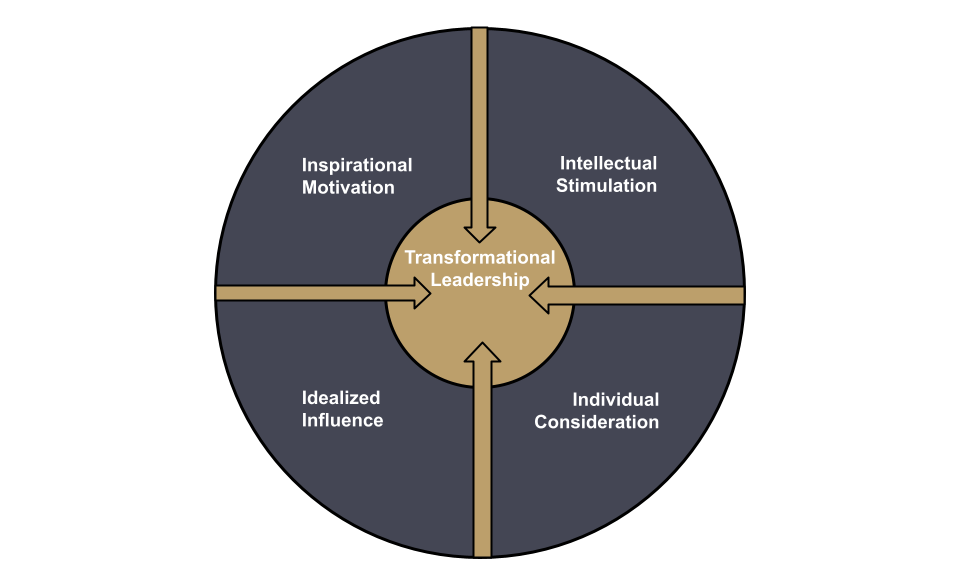Transformational Leadership: How to Motivate & Inspire Teams
 Many leaders are continually on the hunt for fresh ways to motivate their team, increase productivity, and create a supportive atmosphere.
Many leaders are continually on the hunt for fresh ways to motivate their team, increase productivity, and create a supportive atmosphere.
A perennial question in the arena of leadership thinking is simply this: ‘What constitutes good leadership?’
Filtering such questions through a new theoretical framework can be powerful, causing top-down paradigm shifts in the way organizations are run.
One framework that has the potential to cause this degree of change is transformational leadership theory. In this article, we explore its origins, along with several fascinating research findings.
Before you continue, we thought you might like to download our three Positive Leadership Exercises for free. These detailed, science-based exercises will help you or others adopt positive leadership practices and help organizations thrive.
This Article Contains:
- What Is Transformational Leadership Theory?
- Characteristics and Traits: 5 Examples
- How Does It Work? Explaining the Model & Diagram
- Transformational Leadership & Emotional Intelligence
- Is the Style Effective? 5 Research Findings
- Advantages & Disadvantages of Transformational Leadership
- 7 Common Criticisms of Transformational Leadership
- Applying Transformational Leadership in Healthcare
- Using Transformational Leadership in Education: 3 Games
- Assessing Leadership Styles: 4 Questionnaires
- PositivePsychology.com’s Relevant Resources
- A Take-Home Message
- References
What Is Transformational Leadership Theory?
The concept of transformational leadership originated with leadership expert and presidential biographer James MacGregor Burns, who was interested in the leadership styles of historical figures such as Mahatma Gandhi and Franklin D. Roosevelt.
In his impactful book Leadership, Burns (1978, p. 20) describes transformational leaders as those who engage with followers such that they “raise one another to higher levels of motivation and morality.”
How do they achieve this? By embodying an inspiring vision in order to motivate followers to work on shared goals that transcend their self-interest.
It was Bernard M. Bass (1985) who further developed transformational leadership theory in his work Leadership and Performance Beyond Expectations. Along with hypothesizing the psychological mechanisms behind it, Bass argued that its impact can be quantified in terms of subjective impact on followers, including measures like admiration, trust, and respect.
Indeed, a plethora of research has shown transformational leadership to be correlated with such measures, along with favorable outcomes at the level of the organization and employee.
Characteristics and Traits: 5 Examples

When it comes to assessing leadership styles, the role played by certain dispositional factors is well documented. The field of transformational leadership is no different.
For instance, a large 2004 meta-analysis analyzed its link with the Big Five personality traits (Bono & Judge, 2004). Reflecting on these findings, the authors suggested why each trait might predict ratings of transformational leadership behaviors (the first two showing a stronger correlation):
1. Extraversion
A tendency to “convey positive emotions and project optimism and enthusiasm” (Bono & Judge, 2004, p. 908) may account for the link between extraversion and transformational leadership behaviors.
2. Low neuroticism
Transformational leaders are usually high in self-esteem and self-efficacy, while those high in neuroticism tend toward the opposite, given their negatively skewed worldview.
3. Openness to new experience
Two important aspects of transformational leadership are entertaining new ideas and thinking outside the box. Transformational leaders are also more proactive than reactive, working to change organizational culture instead of conforming to the status quo (Odumeru & Ifeanyi, 2013).
4. Conscientiousness
The ability to self-manage without needing supervision is the mark of any outstanding leader. This is especially true of a transformational one, with high levels of internal motivation serving to keep the organization on track.
5. Agreeableness
Those with an agreeable nature often show concern, support, and basic respect for others – all pivotal aspects of transformational leadership.
How Does It Work? Explaining the Model & Diagram
Source: Renjith, Renu, & George, 2015
There are four main components, or domains, of transformational leadership (Bass, 1985):
Idealized influence
Transformational leaders set a high standard of moral and ethical conduct to engender loyalty and respect in their followers. One might say they ‘walk the talk’ or lead by example.
Inspirational motivation
In tandem with this, transformational leaders stimulate the inner emotional worlds of their followers by appealing to higher ideals and values.
They achieve this by tenaciously upholding an inspiring vision linked to clear goals. Rather than obfuscating the vision with jargon, they repeatedly and enthusiastically repeat it to keep it front of mind.
Idealized influence and inspirational motivation are highly correlated, sometimes combined in the research to form the dimension ‘charisma’ (Bass, 1998).
Individualized consideration
Transformational leaders also model concern for their team’s welfare, creating an atmosphere of trust. By coaching and mentoring with empathy, they promote growth and development while garnering meaningful insights into any problems occurring on the ground.
Intellectual stimulation
Lastly, they foster creative, innovative problem solving, as well as a culture that regularly challenges the status quo.
Transformational leadership is often juxtaposed with transactional leadership. The latter leaders “cater to their followers’ immediate self-interests” instead of uplifting the morals of their followers through inspiration (Bass, 1999).
Moreover, they motivate through external incentives (a ‘give-and-take’ approach), defer to the status quo, and manage ‘by exception,’ relying on corrective actions whenever the status quo is breached (Bass, 1985).
Transformational Leadership & Emotional Intelligence

Given its popularity in the media, with claims that EI is virtually synonymous with good leadership, one might expect there to be a strong association.
To recap, there are five elements of emotional intelligence (Cherniss, Goleman, Emmerling, Cowan, & Adler, 1998):
- Self-awareness
The ability to recognize and understand one’s own emotions, as well as one’s effect on other people. - Self-regulation
Being able to manage one’s emotions appropriately. - Social awareness
Skillful interactions that build meaningful relationships. - Empathy
The ability to understand how others are feeling and respond with care. - Self-motivation
Being able to harness passion, as opposed to extrinsic incentives, to fulfill one’s inner needs.
At face value, there appears to be an overlap with the four domains of transformational leadership, but is this borne out in empirical research?
The authors of a 2010 meta-analysis asked exactly this question (Harms & Credé, 2010). While there was indeed a significant link between transformational leadership variables and emotional intelligence parameters, it turned out to be weaker than one might expect.
They concluded, “it is evident that claims of EI being the core of transformational leadership were overstated, but this study does demonstrate that EI may contribute to successful leadership at some level” (Harms & Credé, 2010, p.13).
Is the Style Effective? 5 Research Findings
Some organizations perform to a much higher level, engender more loyalty from workers, and innovate to an unusual degree. Can the transformational leadership style help to account for some of these outcomes? Across a variety of settings, there’s plenty of research suggesting this to be the case.
In their book Transformational Leadership, Bernard Bass and Ronald Riggio (2006) summarize a large body of evidence showing that transformational leadership positively aligns with how well companies, the military, governmental organizations, educational institutions, and nonprofits perform.
Here are five specific research findings that found a link between transformational leadership and employee/organizational effectiveness:
1. Team performance
Lowe, Kroeck, and Sivasubramaniam (1996) established a link between transformational leadership style and team effectiveness across the set of studies included in the meta-analysis. The level of ‘charisma’ was especially correlated with leader effectiveness, as reflected by subordinate perception, supervisor appraisals, and hard measures of organizational outcomes such as meeting profit goals (Lowe et al., 1996).
2. Employee job performance
A more recent meta-analysis revealed a link between transformational leadership and employee job performance, as mediated by mechanisms such as (Ng, 2017):
- Employee task performance
- ‘Citizenship’ behaviors
- The degree of innovative behavior
3. Communication
Another study, which investigated the impact of transformational leadership in small- and medium-sized enterprises, similarly found that such a leadership style was significantly related to not only citizenship behavior but also employee retention (Tian et al., 2020).
Interestingly, the researchers took this further to reveal that communication moderates these relationships. This coheres with the elements of transformational leadership, which emphasize the conveying of an inspiring mission to the team.
4. Employee outcomes
This study looked at questionnaire data from social service employees, as well as interview data from managers in three empirical studies. Transformational leadership was positively correlated with employee outcomes, including ‘commitment’ and ‘role clarity’ (Tafvelin, 2013).
These effects were further enhanced by the degree of coworker support, reflecting the importance of not only leader–follower but also follower–follower relationships.
5. Inspirational motivation
This Swedish study evaluated 128 leaders across different sectors to see whether transformational leadership domains are predictive of organizational outcomes. All four components were significantly correlated with not only employee effectiveness but also higher job satisfaction, with ‘inspirational motivation’ producing the greatest amount of extra effort on the job (Zineldin, 2017).
Advantages & Disadvantages of Transformational Leadership

For one, inspirational motivation has been linked to employee enthusiasm, hopefulness, pride, happiness, attentiveness, and inspiration (Zineldin, 2017). This may culminate in a general rise in job satisfaction, along with improved mental health both at work and at home.
Previous studies (e.g., Jacobs et al., 2013) have similarly correlated transformational leadership with follower wellbeing, even after controlling for potential confounding factors like job difficulty, education level, and age.
Despite the clear advantages of the approach, there are noteworthy drawbacks of transformational leadership.
To begin with, it isn’t a blanket solution to be used in every scenario and across every setting. Some argue that some teams need a more transactional style, meaning closer supervision and greater direction. This might especially be the case when followers are unskilled and require more oversight.
Transformational leadership is also more effective when applied in smaller, privately held organizations compared to larger, more complex ones (Ling, Simseck, Lubatkin, & Veiga, 2008).
7 Common Criticisms of Transformational Leadership
Despite the mostly positive press regarding transformational leadership, some researchers have pointed out conceptual holes in its underpinning theory. Management professor Gary Yukl (1999), for instance, has generated a list of seven major criticisms, detailed below.
1. Limited interest in group-level processes
Yukl argues that too much emphasis is put on how well the leader influences individual followers, rather than how the group functions. For example, the theory cannot account for how well leadership activities are coordinated or how efficiently resources are utilized.
2. Ambiguity about transformational behaviors
Secondly, the theory may fall short in terms of its clarity. Yukl is one of many to criticize the vagueness of the four components, given the overlapping descriptions and high inter-correlation among them. There is also little mention of how each domain gives rise to improved performance outcomes, making it tricky to organize appropriate training for leaders.
3. Ambiguity about transactional leadership
Another criticism is that transactional leadership is identified by a diverse collection of behaviors that “lack any clear common denominator” (Yukl, 1999, p. 289). Yukl points out that providing ‘praise’ and ‘recognition’ encompasses transformational as well as transactional leadership, blurring the distinction between the two.
4. Omission of important behaviors
Yukl identified several leadership behaviors that translate to improved organizational outcomes yet are not included in transformational leadership theory. These include enhancing follower skillsets and sharing power.
5. Insufficient specification of situational variables
While the original theory assumed transformational leadership to be uniformly beneficial in all situations, Yukl points out factors likely to place a ceiling on how effective it can be in practice, such as the lack of ‘environment stability’ and an ‘entrepreneurial culture.’
6. Insufficient identification of negative effects
The theory doesn’t address potential negative effects of this leadership style. One suggestion is that followers can become “transformed to such a high degree of emotional involvement in the work that over time they become ‘burned out’ by the prolonged stress” (Yukl, 1999, p. 292).
Furthermore, there might be a risk of followers becoming so devoted that they blindly follow charismatic leaders without questioning the underlying ethical principles.
7. Heroic leadership stereotype
Finally, Yukl points out that transformational leadership theory (like earlier leadership theories) succumbs to heroic leadership bias – the assumption that performance depends primarily on leadership style rather than individual factors. In other words, the focus is mainly on top-down as opposed to bottom-up influence.
Applying Transformational Leadership in Healthcare

Through all levels of a healthcare system, effective leadership is recognized as integral to desirable outcomes, whether in relation to clinical staff or local, regional, and national leaders.
In 2015, independent British charity The King’s Fund conducted an evidence review on healthcare leadership (West et al., 2015). Having analyzed the research, the authors stipulated five key elements of optimum leadership in healthcare settings:
- Inspiring visions at every level, along with upholding a shared, holistic view of care
- Clear, aligned objectives for all teams, departments, and individual staff
- Supportive and enabling people management and high levels of staff engagement
- Learning, innovation, and quality improvement embedded in the practice of all staff
- Effective teamwork
The overlap between these criteria and the four components of transformational leadership is clear, with the paper noting that the included studies provided “strong support for transformational leadership” in healthcare settings (West et al. 2015). They also noted links with “staff satisfaction, unit or team performance, organizational climate and turnover intentions” (West et al., 2015, p. 10).
There were also positive effects in relation to employee work–life balance, staff wellbeing, positive nursing outcomes, patient safety, openness about errors, and patient/staff satisfaction.
Using Transformational Leadership in Education: 3 Games
When it comes to becoming a better leader, reading up on theory is only part of the equation. After all, leadership isn’t primarily an academic exercise, but a lived experience.
That said, there are plenty of exercises that can be used to cultivate the four components of transformational leadership. Any approach that emphasizes reflection on values, a cohesive vision, group collaboration, intellectual stimulation, and creative problem solving will be consistent with this.
The following three games make participants consider what it is to be an effective transformational leader.
1. Leadership crest
Participants are asked to create a family crest that visually represents their organization. The crest is to be broken into four categories, such as ‘values,’ ‘beliefs,’ ‘strengths,’ and any other category they can think of.
Not only will this inspire creativity, but it will also encourage thinking around the organizational story and vision. Afterward, reflection might focus on how well each team’s crest aligns with each other (Landau, 2018).
2. Desert island
In this game, each team has to agree on just five items they would take if stranded on a desert island. This activity reveals any mismatch between the priorities of participants and tests their ability to make compromises for the greater good of surviving together.
It can be a useful exercise for companies, emphasizing the importance of managing limited resources and banding together for a common goal (Landau, 2018).
3. Tallest tower
Participants are given everyday items like toothpicks, wooden blocks, and uncooked pasta. The task is to construct the tallest possible free-standing structure from the materials provided. This game encourages creative problem solving, thinking outside the box, and collaboration – all elements of effective transformational leadership (Stepshift, 2016).
Assessing Leadership Styles: 4 Questionnaires

There are validated leadership questionnaires, many of which are accessible via online repositories such as StatisticsSolutions.com and mindgarden.com.
Here are four worth noting:
1. Multifactor Leadership Questionnaire (MLQ)
Comprising 36 items pertaining to leadership styles and 9 items pertaining to leadership outcomes, the MLQ, developed by Bass and Avolio (1990), is the gold standard for measuring transformational leadership.
It is designed as a 360-degree instrument, taking data from the leader’s superiors, peers, subordinates, and others. Much of the research on transformational leadership utilizes the MLQ, given its validation across many cultures and types of organizations (Bass & Riggio, 2006, p. 21).
2. Authentic Leadership Questionnaire (ALQ)
The ALQ is often combined with the MLQ and measures components of authentic leadership like self-awareness, transparency/openness, and ethical/moral conduct (Walumbwa, Avolio, Gardner, Wernsing, & Peterson, 2008).
3. Leadership Assessment Inventory (LAI)
Though not used in research that often, the LAI can also measure both transformational and transactional leadership behaviors. It comes with a self-rating and observer-rating form, assessing 37 attributes linked to successful leadership performance (Burke, 1994).
4. Leadership Practices Inventory (LPI)
The LPI is another tool that can measure leadership, including transformational leadership style (though it is not explicitly labeled as such).
Both leaders and their team members rate the leader on 30 items using a 10-point Likert scale. Note that while often used in workplace settings, the LPI isn’t often used in research (Posner & Kouzes, 1988).
PositivePsychology.com’s Relevant Resources
If you’re a leader or help leaders become more effective, check out the following free resources from our blog:
- Empathy Bingo
This worksheet can help leaders and their teams practice differentiating between empathy and other responses they may have during dialog with others, including interrogating, storytelling, or consoling. - Generating Alternative Solutions and Better Decision-Making
This worksheet can help a leader and their team systematically practice better decision-making by brainstorming many alternative solutions to a problem. - Spotting Good Traits
This worksheet can be adapted for use with a group of leaders as a way to help them spot and reflect on positive leadership traits. Consider inviting a group to share positive leadership traits they have observed in one another at the beginning of the exercise. - Writing Your Mission Statement
This worksheet guides users through a series of four questions to help clarify links between values, skills, and the impact they wish to leave on the world.
If you’re looking for more science-based ways to help others develop positive leadership skills, this collection contains 17 validated positive leadership exercises. Use them to equip leaders with the skills needed to cultivate a culture of positivity and resilience.
Another great resource for transformational leadership is our Positive Relationships Masterclass©, which provides practical tools to build long-lasting relationships.
A Take-Home Message
Whether it’s for a small startup or large, multifaceted organization, the quality of leadership can make all the difference when it comes to achieving both objective success and subjective wellbeing. As the evidence has shown, adopting a transformational style may well be integral to these ends.
While transformational leadership likely won’t offer a ‘quick fix’ – especially for larger organizations resistant to change – this isn’t grounds for despondency.
It’s never too late to change the approach, and the power of a compelling, inspiring vision to motivate shouldn’t be underestimated.
We hope you enjoyed reading this article. Don’t forget to download our three Positive Leadership Exercises for free.
- Bass, B. M. (1985). Leadership and performance beyond expectations. The Free Press.
- Bass, B. M. (1998). Transformational leadership: Industrial, military, and educational impact. Erlbaum.
- Bass, B. M. (1999). Two decades of research and development in transformational leadership. European Journal of Work and Organizational Psychology, 8(1), 9–32.
- Bass, B. M., & Avolio, B. J. (1990). Transformational leadership development: Manual for the multifactor leadership questionnaire. Consulting Psychologists Press.
- Bass, B. M., & Riggio, R. E. (2006). Transformational leadership (2nd ed.). Lawrence Erlbaum Associates.
- Bono, J. E., & Judge, T. A. (2004). Personality and transformational and transactional leadership: A meta-analysis. Journal of Applied Psychology, 89(5), 901–910.
- Burke, W. W. (1994). Leadership Assessment Inventory. Warner Burke and Associates.
- Burns, J. M. (1978). Leadership. Harper & Row.
- Cherniss, C., Goleman, D., Emmerling, R., Cowan, K., & Adler, M. (1998). Bringing emotional intelligence to the workplace: A technical report issued by the consortium for research on emotional intelligence in organizations. The Consortium for Research on Emotional Intelligence in Organizations.
- Harms, P. D., & Credé, M. (2010). Emotional intelligence and transformational and transactional leadership: A meta-analysis. Journal of Leadership & Organizational Studies, 17(1), 5–17.
- Jacobs, C., Pfaff, H., Lehner, B., Driller, E., Nitzsche, A., Stieler-Lorenz, B., … Jung, J. (2013). The influence of transformational leadership on employee well-being: results from a survey of companies in the information and communication technology sector in Germany. Journal of Occupational and Environmental Medicine, 55(7), 772–778.
- Posner, B. Z., & Kouzes, J. M. (1988). Development and validation of the Leadership Practices Inventory. Educational and Psychological Measurement, 48(2), 483–496.
- Landau, P. (2018, September 13). The 9 best leadership games for skill development. Project Manager. Retrieved on May 2, 2021, from https://www.projectmanager.com/blog/the-9-best-leadership-games
- Ling, Y., Simseck, Z., Lubatkin, M. H., & Veiga, J. F. (2008). The impact of transformational CEOs on the performance of small- to medium-sized firms: Does organizational context matter? Journal of Applied Psychology, 93(4), 923–934.
- Lowe, K. B., Kroeck, K. G., & Sivasubramaniam, N. (1996). Effectiveness correlates of transformational and transactional leadership: A meta-analytic review of the MLQ literature. The Leadership Quarterly, 7(3), 385–415.
- Ng, W. H. T. (2017). Transformational leadership and performance outcomes: Analyses of multiple mediation pathways. The Leadership Quarterly, 28(3), 385–417.
- Odumeru, J., & Ifeanyi, G. (2013). Transformational vs. transactional leadership theories: Evidence in literature. International Review of Management and Business Research, 2(2), 355–361.
- Renjith, V., Renu, G., & George, A. (2015). Transformational leadership in nursing. International Journal of Scientific Research and Management Studies, 2, 112–118.
- Stepshift. (2016, July 6). Leadership training activities. Retrieved on May 2, 2021, from https://www.stepshift.co.nz/blog/developing-team-performance-with-senior-leadership-teams/strategic-planning-with-an-independent-facilitator/leadership-training-activities.html
- Tafvelin, S. (2013). The transformational leadership process: Antecedents, mechanisms, and outcomes in the social services (Doctoral dissertation). Umeå University, Sweden.
- Tian, H., Iqbal, S., Akhtar, S., Qalati, S. A., Anwar, F., & Khan, M. A. S. (2020). The impact of transformational leadership on employee retention: Mediation and moderation through organizational citizenship behavior and communication. Frontiers in Psychology, 11, 314.
- Walumbwa, F., Avolio, B., Gardner, W., Wernsing, T., & Peterson, S. (2008). Authentic leadership: Development and validation of a theory-based measure. Journal of Management, 34(1), 89–126.
- West, M., Armit, K., Loewenthal, L., Eckert, R., West, T., & Lee, A. (2015). Leadership and leadership development in health care: The evidence base. Faculty of Medical Leadership and Management, Center for Creative Leadership, The King’s Fund.
- Yukl, Y. (1999). An evaluation of conceptual weaknesses in transformational and charismatic leadership theories. The Leadership Quarterly, 10(2), 285–205.
- Zineldin, M. (2017). Transformational leadership behavior, emotions, and outcomes: Health psychology perspective in the workplace. Journal of Workplace Behavioral Health, 32(1), 14–25.
Let us know your thoughts
Read other articles by their category
- Body & Brain (49)
- Coaching & Application (57)
- Compassion (26)
- Counseling (51)
- Emotional Intelligence (24)
- Gratitude (18)
- Grief & Bereavement (21)
- Happiness & SWB (40)
- Meaning & Values (26)
- Meditation (20)
- Mindfulness (45)
- Motivation & Goals (45)
- Optimism & Mindset (34)
- Positive CBT (28)
- Positive Communication (20)
- Positive Education (47)
- Positive Emotions (32)
- Positive Leadership (18)
- Positive Parenting (4)
- Positive Psychology (33)
- Positive Workplace (37)
- Productivity (17)
- Relationships (46)
- Resilience & Coping (36)
- Self Awareness (21)
- Self Esteem (38)
- Strengths & Virtues (32)
- Stress & Burnout Prevention (34)
- Theory & Books (46)
- Therapy Exercises (37)
- Types of Therapy (64)






What our readers think
Learnt a lot from this piece. Thank you, Dr, Oliver for sharing your in-depth knowledge on this matter of Transformational leadership.